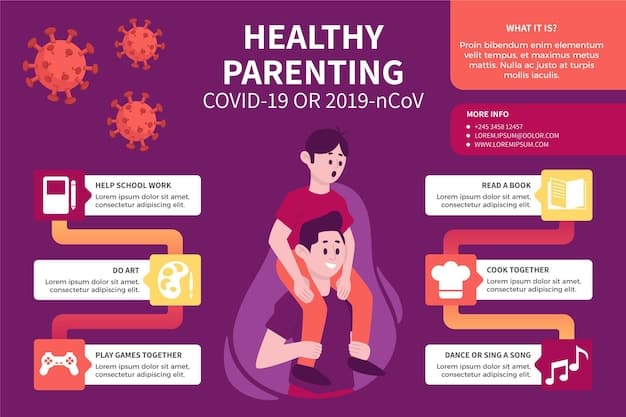Updated Federal Guidelines for Mental Health Support in the Workplace 2025

The updated federal guidelines for mental health support in the workplace in 2025 aim to enhance employee well-being through comprehensive programs, emphasizing prevention, access to care, and the reduction of stigma associated with mental health issues.
Navigating the complexities of workplace mental health is crucial for both employees and employers. As we approach 2025, understanding the updated federal guidelines for mental health support in the workplace is essential for fostering a healthy and productive work environment.
Understanding the Need for Updated Mental Health Guidelines
The landscape of mental health in the workplace has evolved significantly in recent years. Increased awareness, coupled with the challenges posed by modern work environments, necessitates updated guidelines to support employee well-being and ensure compliance with evolving legal standards.
These updated guidelines are designed to address gaps in existing policies, promote proactive mental health strategies, and create a more inclusive and supportive workplace culture for everyone.
Why Update the Guidelines?
Several factors have contributed to the need for updated federal guidelines. These include:
- Increased Awareness: Greater public and organizational awareness of mental health issues.
- Evolving Legal Standards: Changes in legislation and legal interpretations related to workplace mental health.
- Modern Workplace Challenges: The impact of technology, remote work, and globalization on employee mental well-being.
These factors underscore the importance of having clear, comprehensive guidelines in place to ensure that employers are equipped to support their employees effectively.
In conclusion, updated guidelines are not just a matter of compliance, but a proactive step towards creating a healthier, more productive, and inclusive workplace for all.
Key Changes in the 2025 Federal Guidelines
The 2025 federal guidelines introduce several key changes aimed at enhancing mental health support in the workplace. These changes encompass various aspects, from prevention and early intervention to access to care and destigmatization efforts.
Let’s delve into the specific updates and what they mean for both employers and employees.

The key updates include:
- Enhanced Prevention Strategies: Emphasis on proactive measures to prevent mental health issues from arising.
- Improved Access to Care: Streamlined pathways for employees to access mental health services.
- Destigmatization Initiatives: Programs and policies designed to reduce the stigma associated with mental health.
Focus on Prevention
The updated guidelines place a significant emphasis on prevention. This involves implementing strategies that proactively address potential stressors and promote mental well-being before issues escalate.
This proactive approach includes:
- Stress management programs
- Work-life balance initiatives
- Training for managers to recognize and address early signs of mental health issues
By focusing on prevention, organizations can create a healthier work environment and reduce the likelihood of employees experiencing mental health challenges.
To summarize, the key changes in the updated federal guidelines reflect a proactive and comprehensive approach to mental health support in the workplace.
Implementing Comprehensive Mental Health Programs
Implementing comprehensive mental health programs is crucial for creating a supportive and productive workplace. These programs should be designed to address a range of needs, from prevention and early intervention to access to care and ongoing support.
A well-designed program can significantly improve employee well-being and organizational performance.
A comprehensive program should include:
- Mental Health Training: Training programs for employees and managers.
- Employee Assistance Programs (EAPs): Confidential counseling and support services.
- Wellness Initiatives: Programs promoting physical and mental well-being.
The Role of Mental Health Training
Mental health training is a critical component of any comprehensive program. It equips employees and managers with the knowledge and skills to recognize, understand, and respond to mental health issues effectively.
This includes:
- Recognizing signs and symptoms of common mental health conditions
- Providing support and resources to colleagues in need
- Promoting self-care and stress management techniques
By investing in mental health training, organizations can create a more informed and supportive workplace culture.
In conclusion, implementing comprehensive mental health programs is essential for fostering a healthy and productive workplace.
Legal and Compliance Considerations for Employers
Navigating the legal and compliance landscape is a critical aspect of providing mental health support in the workplace. Employers must be aware of their obligations under federal laws such as the Americans with Disabilities Act (ADA) and the Family and Medical Leave Act (FMLA).
Ensuring compliance not only protects the rights of employees but also mitigates potential legal risks for the organization.
Key legal considerations include:
- The Americans with Disabilities Act (ADA): Protecting employees with mental health conditions from discrimination.
- The Family and Medical Leave Act (FMLA): Providing job-protected leave for employees with serious health conditions, including mental health issues.
- Confidentiality and Privacy: Ensuring the privacy of employee medical information.
ADA and Mental Health
The ADA prohibits discrimination against qualified individuals with disabilities, including those with mental health conditions. Employers must provide reasonable accommodations to employees with mental health conditions, unless doing so would cause undue hardship.
Reasonable accommodations may include:
- Adjustments to work schedules
- Modifications to job duties
- Providing a quiet workspace
Employers should engage in an interactive process with employees to determine appropriate accommodations.
In summary, understanding and adhering to legal and compliance requirements is essential for employers to create a fair and supportive workplace.
Resources and Support Systems for Employees
Providing access to resources and support systems is a vital aspect of promoting mental health in the workplace. Employees should have access to a range of services that can help them manage stress, cope with mental health challenges, and improve their overall well-being.
These resources should be readily available and easy to access, promoting a culture of support and care.

Key resources include:
- Employee Assistance Programs (EAPs): Offering confidential counseling and support services.
- Mental Health Apps: Providing access to tools for stress management, mindfulness, and mood tracking.
- Support Groups: Creating opportunities for employees to connect and share experiences.
The Benefits of EAPs
Employee Assistance Programs (EAPs) are a valuable resource for employees experiencing mental health challenges. EAPs provide confidential counseling, support, and referral services to help employees address a range of personal and work-related issues.
EAPs can help employees with:
- Stress management
- Anxiety and depression
- Relationship issues
These programs are often available 24/7 and can be accessed online or in person.
In conclusion, providing access to resources and support systems is crucial for promoting mental health and well-being in the workplace.
Creating a Supportive and Inclusive Workplace Culture
Creating a supportive and inclusive workplace culture is essential for promoting mental health. A culture that values empathy, understanding, and open communication can help reduce stigma and encourage employees to seek help when they need it.
Building such a culture requires a commitment from leadership and ongoing efforts to foster a sense of belonging and psychological safety.
Key strategies include:
- Promoting Open Communication: Encouraging employees to talk openly about mental health.
- Reducing Stigma: Challenging negative stereotypes and misconceptions about mental illness.
- Fostering Empathy: Promoting understanding and compassion among colleagues.
The Role of Leadership
Leadership plays a critical role in shaping workplace culture. Leaders who prioritize mental health and demonstrate empathy can set a positive example and encourage others to do the same.
This includes:
- Openly discussing their own experiences with mental health
- Supporting mental health initiatives and programs
- Creating a safe space for employees to share their concerns
By demonstrating a commitment to mental health, leaders can create a more supportive and inclusive workplace for everyone.
In conclusion, creating a supportive and inclusive workplace culture is vital for promoting mental health and well-being among employees.
| Key Point | Brief Description |
|---|---|
| 🌱 Prevention Strategies | Focus on proactive measures like stress management programs. |
| 🤝 Legal Compliance | Adhere to ADA and FMLA for employee protection. |
| ℹ️ Resource Access | Provide EAPs, mental health apps, and support groups. |
| 🗣️ Culture Building | Promote open communication and reduce stigma. |
Frequently Asked Questions
▼
The primary goals include enhancing prevention, improving access to care, and reducing stigma around mental health in the workplace, ensuring a supportive environment for all employees.
▼
The ADA prohibits discrimination and requires employers to provide reasonable accommodations to qualified individuals with mental health conditions, unless it causes undue hardship.
▼
EAPs provide confidential counseling, support, and referral services to help employees manage stress, cope with mental health challenges, and improve their overall well-being.
▼
A supportive and inclusive workplace culture reduces stigma, fosters empathy, and encourages employees to seek help when needed, promoting overall mental well-being.
▼
Key strategies include stress management programs, work-life balance initiatives, and training for managers to recognize and address early signs of mental health issues.
Conclusion
As we look ahead to 2025, the updated federal guidelines for mental health support in the workplace represent a significant step towards creating healthier, more supportive work environments. By understanding and implementing these guidelines, employers can foster a culture of well-being, ensure compliance with legal standards, and ultimately, improve the lives of their employees.





